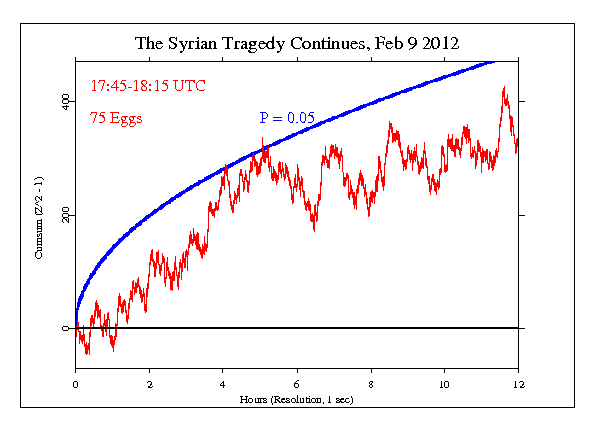|
The GCP technology is not well designed for long drawn-out events such
as the ongoing attempts by the Syrian regime to crush demonstrations by
people opposed to Bashar al-Assad's rule. Seen as a part of the "Arab Spring"
the relatively peaceful demonstrations have so far been unsuccessful in
creating a change, and indeed have been met with increasingly violent
military action by the government. For the GCP, the best tactic we have
for looking at such an "event" is to make a probe that examines a
relatively sharp point in time. We can select a few hours, up to a full
day as representative because that period is a sharply defined example
or sample of the ongoing tragedy. Here we look at the daylight hours of
Feb 9 2012 -- representing the
bombing in Homs, where the Syrian military has focused its attempts to
stamp out the resistance.
From The Globe and Mail:
As atrocities mount in Syria, international community struggles to
choose course of action
Scores more were killed Thursday as artillery salvo pounded Homs – the
battered and bloodied Syrian city targeted by President Bashar
al-Assad’s loyal security forces for a brutal repression.
“The appalling brutality we are witnessing in Homs, with heavy weapons
firing into civilian neighbourhoods, is a grim harbinger of things to
come,” said UN Security-General Ban Ki-moon, warning of even worse if
full-blown civil war erupts.
Appeals for help from Homs, where makeshift hospitals were reportedly
overflowing with the dying and food was scarce in some besieged
neighbourhoods, came after a week of sniper fire and machine-gun
barrages. The day’s death toll, impossible to confirm, was said to be
more than 100 by nightfall, according to eyewitnesses and beleaguered
medical staff.
The GCP event was set for approximately sunrise to sundown (8 am to 8pm
local, 06:00 to 18:00 UTC). The result is Chisquare 43519 on 43200 df,
for p = 0.139 and Z = 1.084.

It is important to keep in mind that we have only a tiny
statistical effect, so that it is always hard to distinguish
signal from noise. This means that every "success" might be
largely driven by chance, and every "null" might include a real
signal overwhelmed by noise. In the long run, a real effect can
be identified only by patiently accumulating replications of
similar analyses.
|